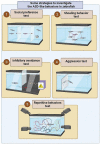Zebrafish Modeling of Autism Spectrum Disorders, Current Status and Future Prospective
- PMID: 35911241
- PMCID: PMC9329562
- DOI: 10.3389/fpsyt.2022.911770
Zebrafish Modeling of Autism Spectrum Disorders, Current Status and Future Prospective
Abstract
Autism spectrum disorder (ASD) refers to a complicated range of childhood neurodevelopmental disorders which can occur via genetic or non-genetic factors. Clinically, ASD is associated with problems in relationships, social interactions, and behaviors that pose many challenges for children with ASD and their families. Due to the complexity, heterogeneity, and association of symptoms with some neuropsychiatric disorders such as ADHD, anxiety, and sleep disorders, clinical trials have not yielded reliable results and there still remain challenges in drug discovery and development pipeline for ASD patients. One of the main steps in promoting lead compounds to the suitable drug for commercialization is preclinical animal testing, in which the efficacy and toxicity of candidate drugs are examined in vivo. In recent years, zebrafish have been able to attract the attention of many researchers in the field of neurological disorders such as ASD due to their outstanding features. The presence of orthologous genes for ASD modeling, the anatomical similarities of parts of the brain, and similar neurotransmitter systems between zebrafish and humans are some of the main reasons why scientists draw attention to zebrafish as a prominent animal model in preclinical studies to discover highly effective treatment approaches for the ASD through genetic and non-genetic modeling methods.
Keywords: Danio rerio; animal modeling; autism spectrum disorders; drug development; drug discovery; zebrafish.
Copyright © 2022 Tayanloo-Beik, Hamidpour, Abedi, Shojaei, Tavirani, Namazi, Larijani and Arjmand.
Conflict of interest statement
The authors declare that the research was conducted in the absence of any commercial or financial relationships that could be construed as a potential conflict of interest.
Figures


References
-
- Larijani B, Alavi-Moghadam S, Goodarzi P, Rezaei-Tavirani M, Payab M, Gholami M, et al. Cell therapy targets for autism spectrum disorders: hopes, challenges and future directions. Adv Exp Med Biol. (2020) 1341:107–24. - PubMed
Publication types
LinkOut - more resources
Full Text Sources

